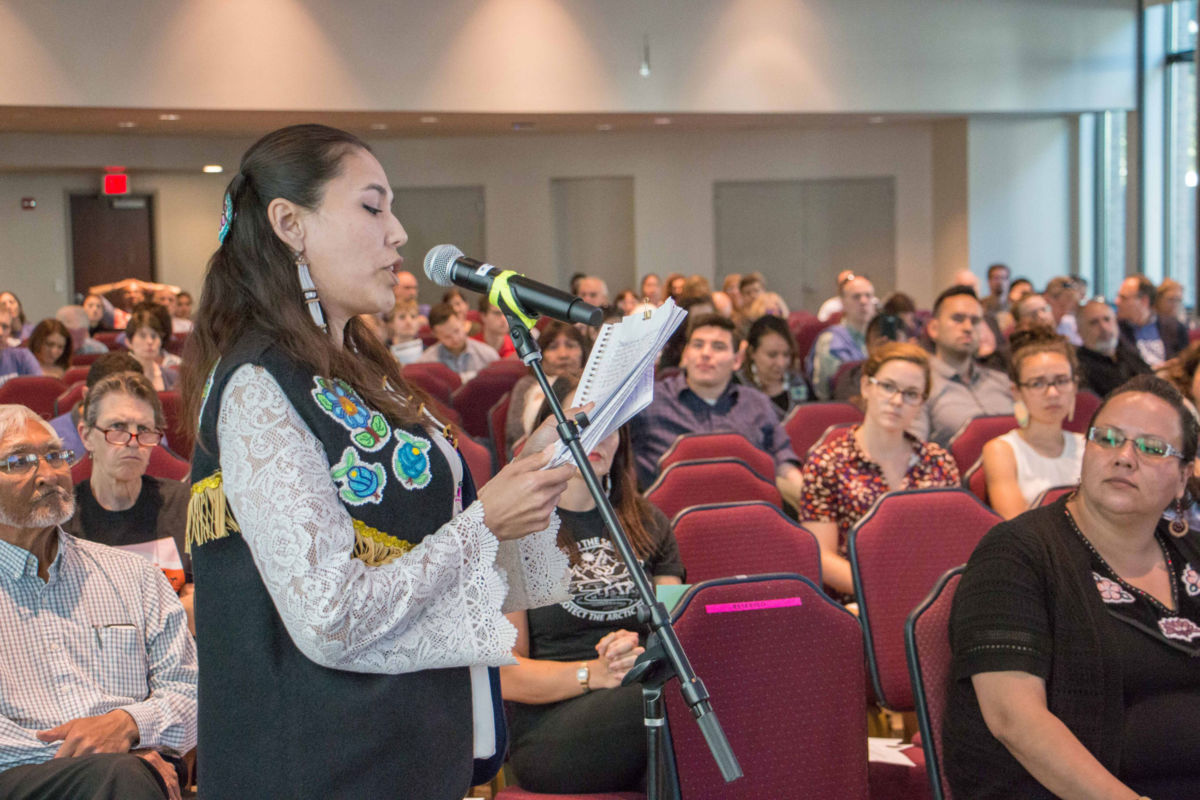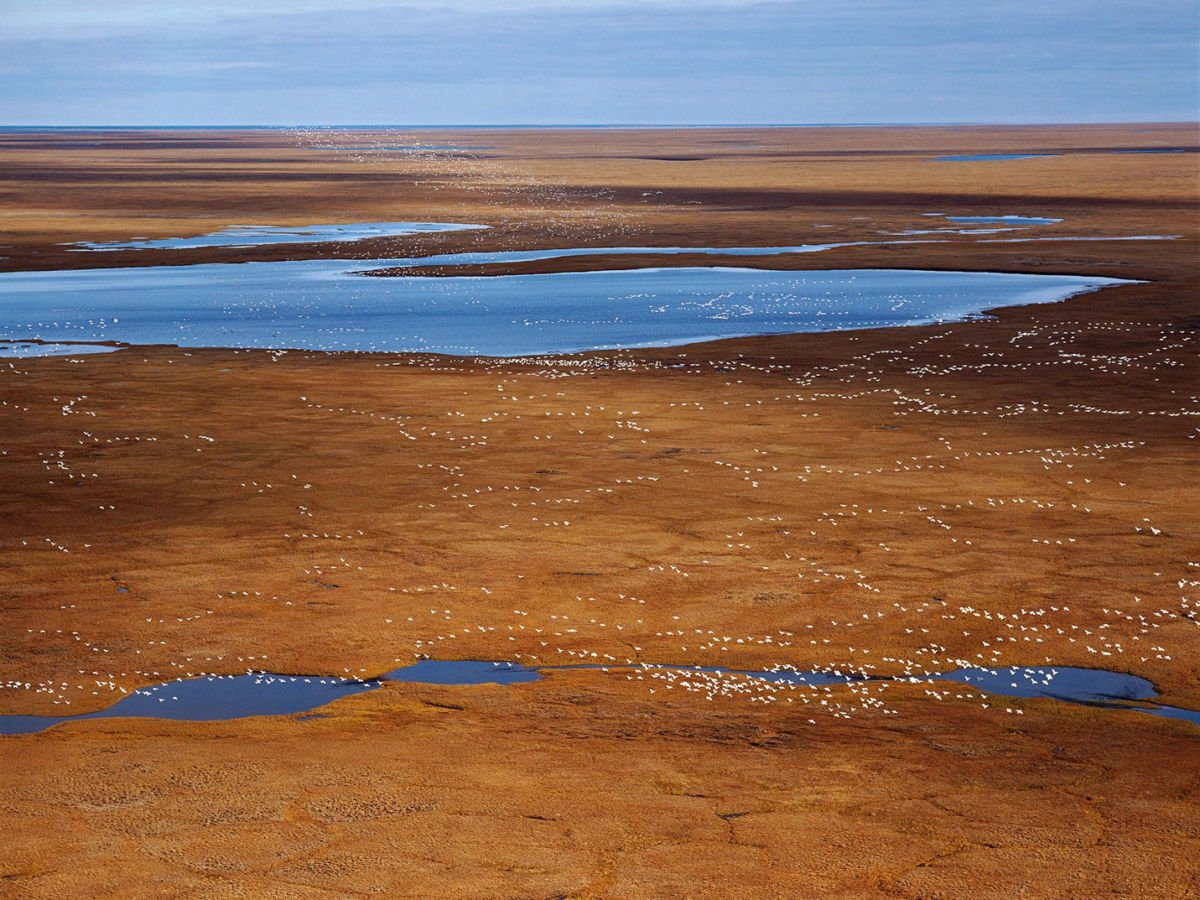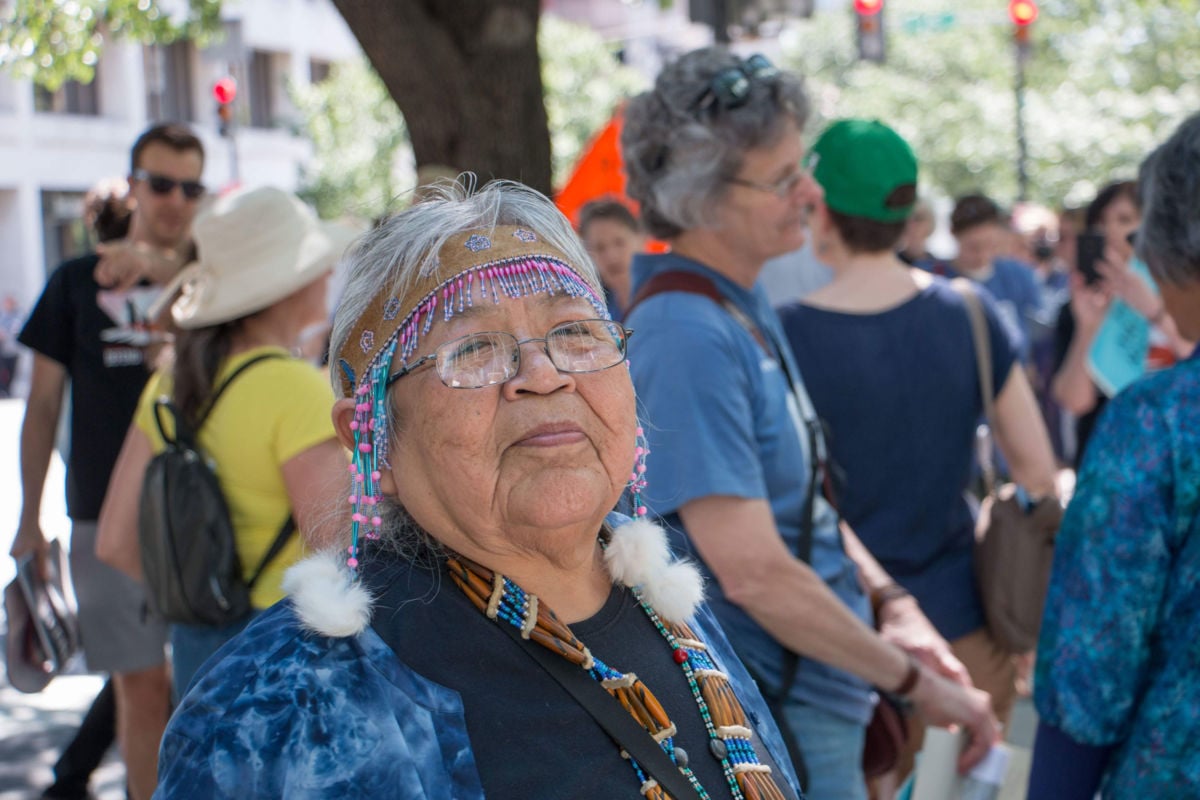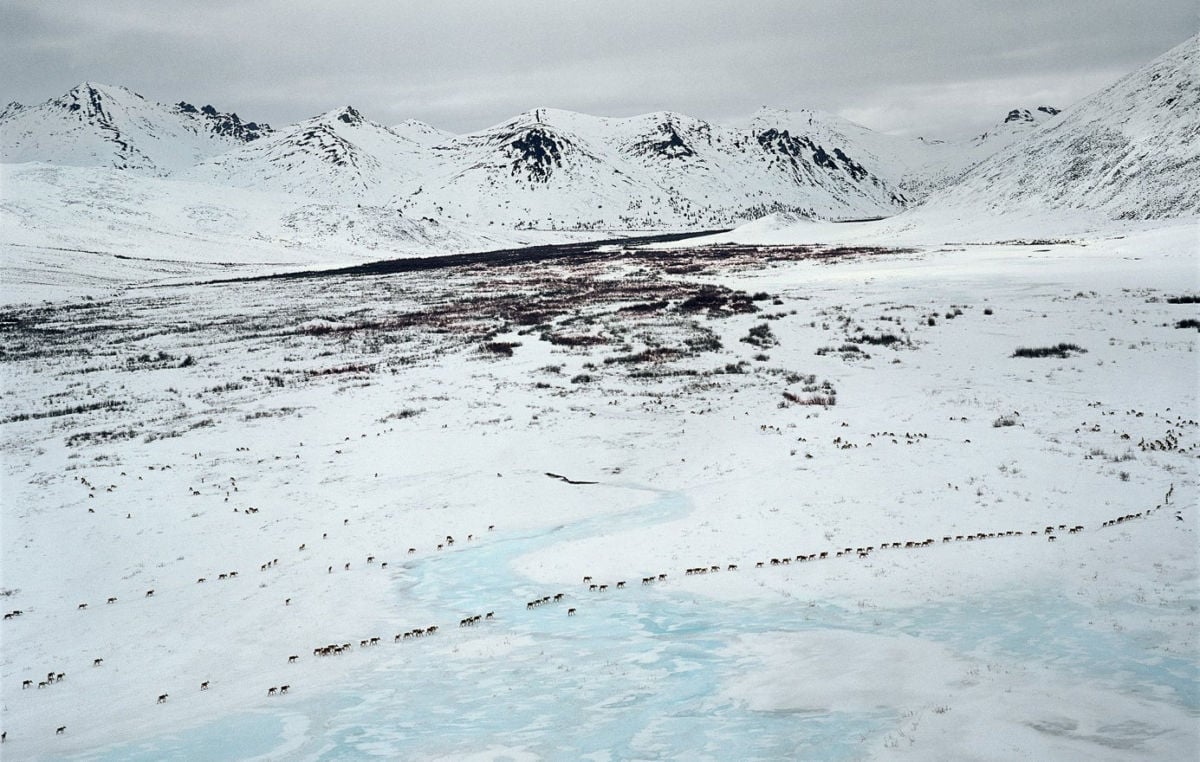Did you know that Truthout is a nonprofit and independently funded by readers like you? If you value what we do, please support our work with a donation.
“What side of history do you want to be on?” Indigenous Alaskan Tonya Garnett asked the Department of Interior officials seated at the dais. “What legacy do you want to leave behind for your children?”
Garnett had journeyed from her small Gwich’in community of Venetie, Alaska, to speak on behalf of her people. “Our way of life is at stake,” she explained. “We speak for our ancestors, and we speak for our children’s children. I want to see my son — my 9-year-old son — be able to get his first caribou. I want to see his sons or his daughters get theirs.”
Her questions and concerns echoed throughout the evening.
On June 15, in Washington, DC, the Bureau of Land Management (BLM) held its final public hearing for the scoping process on the controversial issue of oil and gas leasing in the Arctic National Wildlife Refuge.
Several months earlier, Republican leaders had snuck an Arctic drilling provision into the 2017 Tax Cuts and Jobs Act, which was approved by Congress and signed by President Trump on December 22, 2017. Ever since, the Trump administration has been moving aggressively to begin seismic testing on the Arctic coastal plain, and to rush through the required Environmental Impact Statement (EIS) on the leasing program. The Tax Cuts and Jobs Act called for an initial lease sale in the next four years, but the administration now claims that it would hold the first sale by next summer. Given the scope of Arctic drilling, the critical importance of the refuge’s habitat and the region’s ever-changing conditions caused by climate change, many speakers testified that a proper EIS should take years to complete, but the Trump administration intends to release its draft in the next several weeks, with a final version slated for early next year. This expedited timeline severely limits public input and prioritizes outcome over process.
For many who testified in DC that evening, the BLM hearing was not merely a bureaucratic exercise; it marked, one speaker noted, a “world historical moment.”
Few, however, learned about this moment. Apart from a couple of articles in the Alaskan press, the hearing went largely unnoticed by the mainstream media. This was by design. Although people all across the US and Canada care about the Arctic Refuge, this was the only hearing the BLM conducted outside of Alaska. Officials scheduled the hearing for a Friday evening in mid-June, the beginning of summer vacation for DC-area schools, at a time when the press was not likely to turn out.
Still, it is worth considering the words of those who spoke that evening, because the fight to protect the refuge is not over. As I sat in the auditorium listening to their comments, I was struck by how many considered the Arctic Refuge in broad terms, connecting it to some of the most pressing issues of our time — Indigenous rights, species extinction, climate change and the state of democracy in the US. Over and over again, they argued that the refuge issue extends well beyond the northeastern corner of Alaska; it tells us something profound about our place in history.
Human Rights, Ecological Connections
Garnett and other Gwich’in speakers emphasized the depth of time their people have lived and thrived in the Arctic. For thousands of years, Gwich’in culture has depended upon the Porcupine caribou herd. Currently numbering more than 200,000, this herd migrates every year from its wintering grounds in Canada to the Arctic coastal plain, where the caribou have their young. The Gwich’in describe the refuge’s coastal plain — the same place the Trump administration wants to drill — as “The Sacred Place Where Life Begins.”
“That place,” Garnett explained, “is part of us. What happens to the caribou will happen to the Gwich’in.”
Dotted across northeastern Alaska and northwestern Canada, Gwich’in communities are intimately connected to the caribou that run through their lands. Drilling would violate their rights, jeopardize their food security and undermine their historic, deeply-felt connection to the caribou. Bernadette Demientieff, the executive director of the Gwich’in Steering Committee, which for 30 years has struggled to protect the coastal plain, asked the panel of Interior officials: “Why are you choosing oil and gas companies … over the human rights of the Gwich’in?”

While we sat in DC, some speakers noted the caribou were at that very moment in the calving grounds, giving birth and nurturing the next generation. Not just caribou, but many species of birds and mammals rely upon this vast nursery. Drilling proponents have denigrated the coastal plain as a “flat, white nothingness,” but it is a place brimming with life, connected ecologically to places across the continent and around the world.
“Each year, millions of birds make an epic journey from this unique place to six continents and all 50 states, including Florida, over 5,000 miles away,” testified Keith Shue, an engineer from upstate New York. “I’ve lived in Florida. I’ve also lived in New York, Virginia and California, so while I may have never set foot in the Arctic Refuge, the refuge has quite literally lived with me my entire life.”

Expediting Drilling Amid Mass Extinction and Climate Change
At the hearing, Subhankar Banerjee, an Indian-born photographer who now lives in New Mexico, considered the oil drilling debate in light of what scientists have termed the Earth’s sixth mass extinction — and the only such die-off caused by human action. “Protecting places where animals replenish their populations, in the midst of the sixth mass extinction that we find ourselves in,” Banerjee stated, “ought to be among our highest ethical obligations. But, instead, the government is considering turning this nursery into an oil field.”
With climate change bearing down on the Arctic, with caribou herds across Canada in severe decline, with polar bears increasingly relying on onshore denning habitats and with species around the world suffering die-offs, the Arctic coastal plain — a biological nursery of international significance — deserves protection now more than ever. “Oil and gas development in the Arctic Refuge Coastal Plain,” Banerjee testified, “would lead to colossal colonial violence on the Gwich’in Nation on both sides of the US-Canada border and ecocide on an incredible diversity of wildlife.”
Several speakers connected the refuge debate to the escalating crisis of climate change, including rapid ice melting in Alaska. They described our current moment as a pivotal time in history in which the US should transition to a sustainable energy future.
“Now is the time when we should be weaning ourselves off of all fossil fuels, not opening up extreme sources of oil” from the refuge, testified Lena Moffitt, senior director of the Sierra Club’s Our Wild America Campaign. “We have to start saying ‘no’ somewhere, and this is the perfect place to start saying ‘no’.”

History and the Ongoing Struggle
The people who testified that evening in DC felt it was important to register their opposition to a short-sighted plan that would threaten Indigenous rights, further the extinction crisis and pour more carbon emissions into the atmosphere. They wanted to defend the Arctic Refuge from ecocide.
The hearing transcripts are now stored on the BLM website. Tucked away in bureaucratic cyberspace, the words spoken that evening matter. John Noël, a DC-based environmental activist, envisioned a time in the future when the testimony would become part of the historical record.
“My only hope today,” he said, “is that this is being recorded and archived, so a high school class can come and look at it in 20 years and say, ‘Wow,’ some kid in the back, ‘Wow, were they really going to hand over the Arctic to the oil industry in 2018, even with a global agreement and moral imperative to peak climate emissions? That was an actual idea? Thank God they couldn’t pull it off’.”
It is not too late to imagine Noël’s dream coming true, to create a future in which Garnett’s son and grandchildren will be able to harvest caribou, to protect this habitat for the birds that have enriched Shue’s life, to insist upon the ethical obligations addressed by Banerjee and to push for the clean energy transition described by Moffitt. It is not too late to overturn this policy, to challenge the administration in court, to wage campaigns in corporate boardrooms and shareholder meetings, to mobilize public concern in defense of the refuge.
Currently, the struggle is taking place on multiple fronts. In Congress, refuge champions have introduced legislation calling for repeal of the Tax Act’s fossil fuel leasing provision. In court, Defenders of Wildlife has recently filed suit against the Trump administration for “failing to release public records related to potential exploration, leasing, and development for oil and gas resources” in the refuge. In the banking and corporate arenas, environmental and Indigenous groups have launched campaigns — some of which have proven successful — urging investors to refuse to support development activities. On December 11, there will be a rally against Arctic drilling — organized by the Gwich’in Steering Committee and Indigenous allies — on Capitol Hill. Once the BLM releases its draft EIS, there will be many other opportunities to engage in this critical debate.
The Arctic Refuge conflict represents the longest-running, frequently-recurring public land debate in US history. For decades, environmentalists, Indigenous representatives, scientists, human rights advocates, religious leaders and others have spoken out to protect this irreplaceable ecological treasure. In previous battles, the grassroots has defeated Goliath.
The refuge is under greater threat than ever before. The Trump administration is trying to lease and drill before the political landscape changes. BLM leaders know what side of history they are on. Like other Trump officials, they are spouting energy dominance and hurrying to develop, even as evidence of climate change, species loss and other serious environmental problems continues to mount. We can’t let them pull this off.
Press freedom is under attack
As Trump cracks down on political speech, independent media is increasingly necessary.
Truthout produces reporting you won’t see in the mainstream: journalism from the frontlines of global conflict, interviews with grassroots movement leaders, high-quality legal analysis and more.
Our work is possible thanks to reader support. Help Truthout catalyze change and social justice — make a tax-deductible monthly or one-time donation today.
